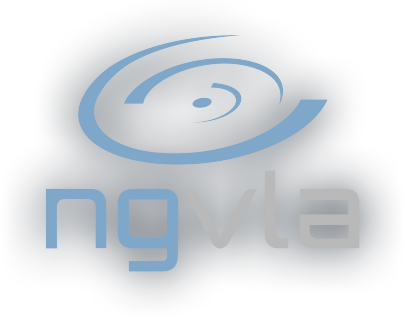ngVLA Tools & Materials
ngVLA Simulations
Simulations of ngVLA observations can be performed in CASA: see this CASA guide for a description of how to perform the simulations and basic imaging. Depending on the science case you are interested in simulating and which array components you choose to include (e.g. Mid vs Mid+Core), the following considerations may apply:
-
To satisfy the requirements of diverse science cases, the ngVLA has multiple components that cover different angular scales. Combining these components together can improve u-v coverage and sensitivity, but introduces non-uniform u-v density across scales, which can make CLEAN deconvolution less stable. A straightforward approach to handling this is Briggs weighting with an appropriately low robust value (often 0 or negative), which reduces the amplitude of the strong, near-field side lobes that can destabilize CLEAN. For detailed guidance on choosing imaging parameters in the context of a CLEAN deconvolution with Briggs weighting, we direct the interested reader to ngVLA memos 55, 65, and 106. More optimal imaging strategies for the ngVLA are an active area of investigation.
-
To obtain the correct primary beam for the SBA (6 m antennas), a special procedure is required--- see page 11 of ngVLA memo 43.
-
General purpose heterogeneous array imaging--- e.g. simultaneously imaging visibilities from the ngVLA 18 m and 6 m antennas--- is supported from CASA 6.2 onwards, and follows the procedure described in Appendix A of ngVLA memo 67. See also ngVLA memo 89 and the “Heterogeneous Array Imaging” section of the CASA documentation.
CASA-readable configuration files for the ngVLA are distributed with CASA’s data repository, and there is a CASA guide describing how to perform basic ngVLA simulations and imaging. To support the reproducibility of earlier investigations, the CASA data repository contains several versions of the ngVLA configuration that were considered in the past. The currently planned configuration is Revision F (Rev.F). The data repository contains configuration files for the primary, distinct elements of the ngVLA: the SBA, Core, Spiral, Mid, and LONG. You can assemble these into sub-arrays that are well-suited to your particular science case by concatenating the files; if you do, be sure to remove the header information besides that for the first antenna set in the file. For example, a mixed configuration to achieve Spiral resolution but have better sensitivity on short baselines could include Spiral + some number of Core antennas. For more information on the NGVLA configuration and its components, please refer to the ngVLA configuration page. If you need help accessing the configuration files, please see this section of the CASA guide or contact us.
The best practices for selecting a sub-array to achieve a given science goal is a topic of ongoing investigation, and will depend on the data processing strategy that is to be used. Some of the considerations are discussed in ngVLA memo 121, in the context of imaging cases that use CLEAN with Briggs weighting plus u-v tapering to achieve the desired beam. In reality the sub-array selection process will also be influenced by scheduling constraints, the relative oversubscription of different array elements as a function of frequency, and other, practical considerations. In the future we plan to distribute a representative set of ngVLA sub-arrays in addition to the distinct array elements. In the meantime, if you need help selecting or assembling an appropriate sub-array for your simulation please contact us.
ngVLA Sensitivity Calculator
The next generation Exposure Calculator Tool (ngECT) is a web interface for estimating the sensitivity that a variety of representative subarrays of the ngVLA will provide for a given integration time. It can calculate point source and surface brightness sensitivities for both spectral line and continuum use cases. It allows for use of a u-v taper to shape the beam, and accounts for the resulting impact on sensitivity.
Other points noting:
-
The ngECT currently assumes the Rev.D configuration. While the performance of Rev.D and the currently planned Rev.F configuration are very similar in terms of sensitivity, an update is planned.
-
The ngECT does not yet include Briggs robust weights as an option.
-
ngECT documentation is here
ngVLA Receiver Configuration
The receiver configuration has progressed since the Reference Design, with an improved cascade analysis for the preferred 6-band concept.
This latest system noise estimate (Jan. 7, 2024) reflects updates to component selection and simulated performance, and also includes system linearity calculations.




